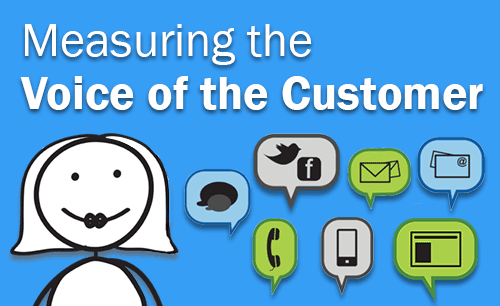Measuring the Voice of the Customer

Understanding what customers want, what they like and incorporating their ideas into future products and services is central to improving customer engagement. This in turn builds loyalty and customer recommendations, driving further sales.
Consequently most large organisations run Voice of the Customer (VoC) programmes that aim to collect data from consumers and use it to make changes that impact the bottom-line. To succeed these VoC programmes have to collect information from every customer touchpoint and channel, so span departments such as sales, marketing and product development.
The customer service department, given its position at the coalface, talking to customers every day, can provide critical input into VoC programmes. Unlike regular, scheduled customer surveys, this input is delivered in real-time, making it an accurate reflection of how the customer feels at the time they were speaking to or interacting with an organisation.
At our recent Eptica customer day, we ran a roundtable session on the Voice of the Customer and customer service, which sparked some fascinating ideas from participants. 5 areas came out of the discussion:
1. Use real-time surveys Organisations want to capture feedback while it is still fresh in the customer’s mind. Therefore it is recommended that surveys are sent immediately after a customer has made contact, and that they are focused on the type of query that they had. Consumers don’t want to wade through pages of questions, so keep it short and to the point. Also, make sure it matches their channel choice – if the customer contacted you via email then don’t send them a survey through the post.
2. Listen to your customers Most companies now record and monitor calls, for regulatory and training purposes, with the agreement of the customer. This is particularly important to ensure that agents have the right skills and training to deliver high levels of service and to deal with any future disputes. However, it also provides insight into what customers are actually asking about. Ensure agents categorise calls by subject, and then listen to a range to get structured insight into customer feedback. If you have a central knowledge management system, monitor which questions and topics are being accessed most often and use this to focus on improving processes and products.
3. Gain feedback from your staff Agents and those dealing directly with customers have unparalleled insight into what customers are saying and thinking. They also provide the ability to capture feedback from those customers that won’t fill in surveys or questionnaires. Therefore make sure you have methods in place to regularly collect their insight and integrate it into VoC programmes.
4. Analyse and categorise digital interactions The rise of digital channels, such as email, chat and social media, unlocks a huge source of written feedback. However, such are the volume of interactions that gaining insight can resemble trying to find a needle in a haystack. Ensure you tag and categorise digital interactions to show what the most popular topics are. At a more advanced level, use linguistics to study the words and phrases used by customers, both individually and at an aggregate level. This enables companies to analyse the context and tone of interactions to measure customer happiness in real-time.
5. Include social media Given its ease and speed, people increasingly provide feedback through social media, either directly or just by mentioning your brand. Make sure you collect this information, act on any issues and integrate it with your other feedback channels. Responsibility for social media can sit with separate teams in some organisations, but it is important to bring it together if you are to gain a holistic picture of your customers.
Voice of the Customer programmes are vital if companies are to get closer to their customers and deepen understanding of their needs. Customer service teams, with their first hand experience of customers are therefore a central part of building and sustaining successful VoC programmes for companies in all sectors.







Comments